Site Selection - The Final Part

It's time for part four of Site Selection! In this part we'll talk about the last of my considerations, fooooood, and we'll take a deep dive into the brain of Andrew Zorowitz of Foam Brain Games, who was on all four site visits and was responsible for asking all the questions publishers and sponsors of the show were going to ask, and probably some they weren't going to ask.
Let's do food first, it's easy.
Baltimore Convention Center is surrounded by restaurants of every price point, from coffee to seafood, and in the surround four blocks are so there are literally two score eating establishments to fit every need. In the morning you can get Duncan, Starbucks, or local coffee, all across the street, and for lunch there is Chipotle, several sandwich chains, and several burger chains, all within three blocks.
When dinner rolls around you can get out into the area and experience a variety of local pubs, neat local pizza or seafood places, and a variety of fine-dining restaurants, whatever you would like.
In Minneapolis, mornings are rough. Muffin Top Cafe just west of the convention center is the closest coffee shop, with Caribou about two blocks north of it. The closest Starbucks (for you loyalists) is a ten minute walk about half a mile away. For lunch and dinner you have access to a variety of diners and fast food joints, including some of the same faux-Mexican, faux-hamburger, and mediocre sandwich places.
At dinner, if you want something nice, there are about half a dozen fine-dining restaurants a fifteen minute walk from the convention center.
Let's get to Chicago! McCormick Place has a sweet view of all the cool things, but they're further than you think they are. Okay, let's be nicer. There are two walkable Starbucks, a Dunkin, and a Momentum Coffee, all accessible for breakfast, Momentum is the furthest at about a 16 minute walk.
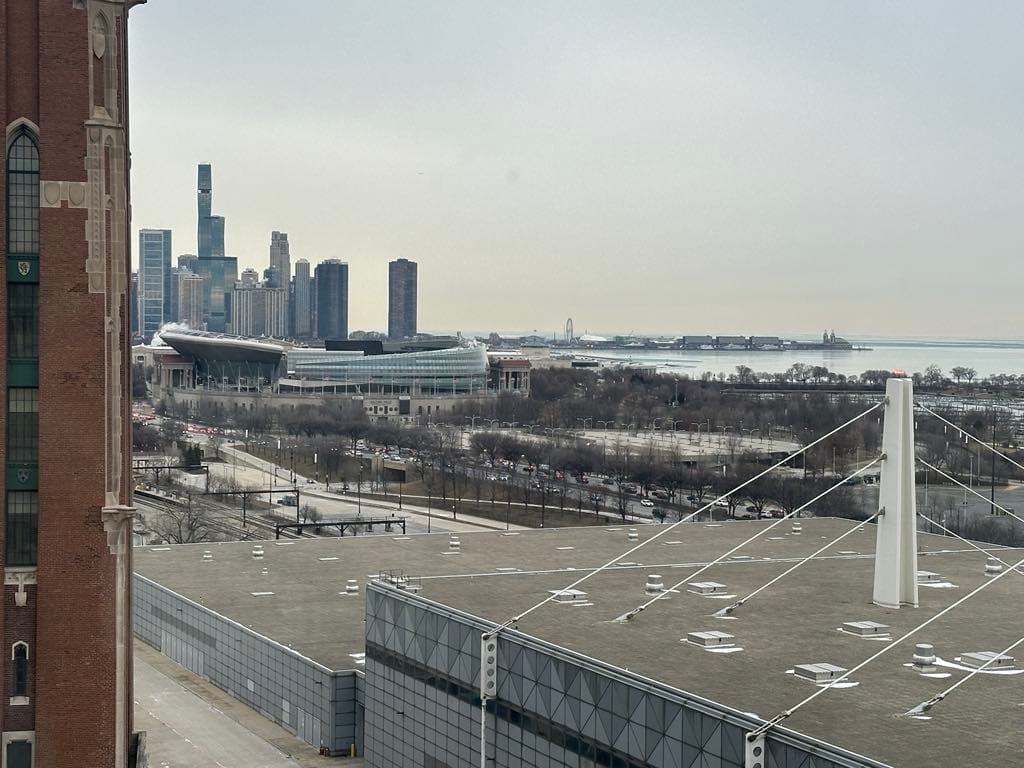
Come lunch time your fast food choices are McDonald's, White Castle, and Shark's Fish and Chips, that's the fast food within a 20 minute walk. When dinner rolls around the nearby selections remain limited, you can get a nice bite at Woven & Bound, inside the Marriott Marquis, make the walk to Williams Inn Pizza, or grab some local brew at Fatpour Tap Works.
If you're willing to wander half a mile outside, at night, in Chicago, in February.
Food options for me were a simple ranking; I'm happiest in Baltimore, I can learn to be okay in Minneapolis, and I was sad in Chicago.
But you're here to dig into Andrew's brain, so let's talk dollar and cents! For this we're going to remember that I attended school for journalism and worked in that industry, so instead of me just sharing thoughts from Andrew's head, I sat down and did a textual interview with Mr. Zorowitz.
J. Stephens (me) - You asked a lot of questions about pricing at all three convention centers. What are the largest expenses for a vendor at EXPO, and how variable did you find those to be in our site visits?
A. Zorowitz (smarter than me) - In order, our largest GAMA Expenses this year:
Driving cost
Hotel Rooms
Decorator costs
Electrical Cost
We try to mitigate our expenses and we understand the venue rules, like drayage and self-loading. We brought in about 1,000 pounds of stuff for our booth.
Me - What does that save?
Andrew - About $1.30 per pound in drayage. This is actually cheap, drayage in Chicago (two days earlier) was $2.90/lb.
Me - That event took place at McCormick Place, the same venue we would use, correct?
Andrew - Correct, and in the exact same part, and with the same decorator. However, I will say other shows I looked at in that center had rates closer to $2.00 to $2.25, so it is not a guarantee the rate would be $3.00.
Me - In your research how did that rate compare to what you found in Minneapolis or Baltimore?
Andrew - Based on the three random shows I looked at, Chicago had the highest rate, but again, that's not a guarantee. To some extent, Minneapolis and Baltimore had more flexible unloading rules for exhibitors, although since the decorator negotiates final rules for exhibitors with the show, that isn't 100% guaranteed either.
Me - Your research also shows questions about rigging a banner, and electricity. Did you find major differences between the convention centers for these things?
Andrew - Yes, about electricity. We didn't get information on rigging, and it is on my follow-up list.
Me - Were there any concerns regarding prices or policies on electricity?
Andrew - Chicago was the most expensive book price, but the decorator sets that, so it's hard to know for sure. Baltimore was the cheaper book price, but they don't have pre-run floor electric throughout the venue, so if you have an in-line booth Baltimore ends up cheaper, but if you have an island there is ninety minutes of labor charges, which means Baltimore becomes more expensive than Minneapolis, but we don't know if Chicago is also added labor for islands since it's set by the decorator.
Minneapolis has pre-run floor electric, so as long as the floorplan isn't dumb there's no additional labor for electric install.
(Editors Note - Andrew means 'you would have to intentionally make a bad floor plan for it to not take advantage of pre-wired spaces, and that would a dumb floor plan.)
Me - What have I missed that is important to vendors at the show?
Andrew - None of this is contractual and the show is three years out...
Me - Wait, wait wait. Now I'm confused. You mean none of these rates would be in our contract?
Andrew - This adds some complexity to evaluating these things, especially in Chicago, where a new union contract could make the situation more expensive. I think it's unlikely for more things to be unionized in any of these cities, but eight years is a long time.
(Editor's Note - Andrew is talking about the time between now and the END of the longest contracts, Minneapolis and Baltimore have both offered five years)
Andrew - So exhibitor services rates are largely attached to the decorator and not the show. The ones that are show or venue driven are usually not contractual, unlike, say, hotel rates, where is the exact rate in the contract is fixed.
Me - So is cost the most important decision maker for a vendor?
Andrew - In terms of whether or not to go to the show? No. In terms of which venue is the best choice? Probably also no. Well, maybe yes, but not in the way you're thinking.
Me - How so?
Andrew - The #1 deciding factor for vendors to go to this show, or any show for that matter, is how many customers are going to be there, and how much access to them are you going to have, and cost is certainly an important factor behind customers choosing to attend.
Me - Do the finalist choices affect that at all? Do you think one choice is way better for the number of customers a vendor has access to?
Andrew - Does it affect it? Yes. Absolutely. As to the second question, I'm not sure.
Me - I believe that attendance in all three places would be relatively equal, with location not being a driving factor (because all are far enough east to be drivable for large number of membership, and all three are easily accessibly by airport).
You think this is a fair assessment?
Andrew - I am genuinely not sure. Attendee and exhibitor experience is my area of expertise when it comes to these kinds of events. That question is somewhat outside my area of expertise.
Me - If the decision was yours and yours alone, from these three finalists, which would you pick?
Andrew - Not answering that. :) (Ed Note - Andrew actually did use a smiley.) While I have a preference I both don't have all of the information (see the list of 100 questions I asked post site visits) and, ultimately, the decision isn't mine.
Me - Do you want to share your preference with all 70 people who read this so far?
Andrew - Nope. I'm happy to discuss it, but I would rather not put it in this article.
END INTERVIEW
Andrew did a lot of research on price points, some it while we still on site visits. It turns out that in my old age I go to bed, and Andrew builds spreadsheets. One of the things he went and tracked was the cost of move a pallet from three generic cities (New York, Los Angeles, and Austin) to each of the three finalist destinations.
Everyone pays more than a $1,000 in shipping to Baltimore, New York and Los Angeles pay more than $1,000 to Chicago (while Austin pays $611), and only New York pays more than $1,000 to Minneapolis (LA was $913, and Austin was $630).
The example pallet was 400 pounds, and the cost does not include drayage, lift gates, or any other additions.
Andrew also went plane ticket shopping while I was sleeping one night, and built some spreadsheets of both domestic and international travel. Rather than summarizing those, I'm sharing them with you here (with Andrew's permission).
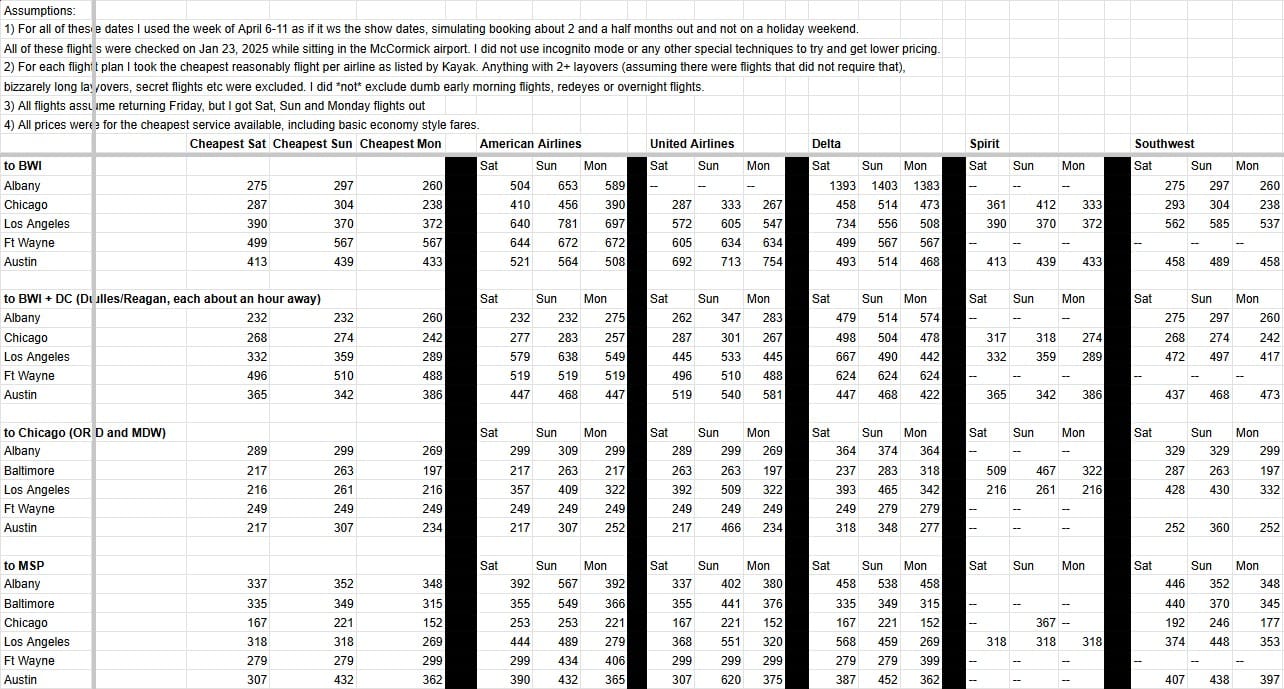
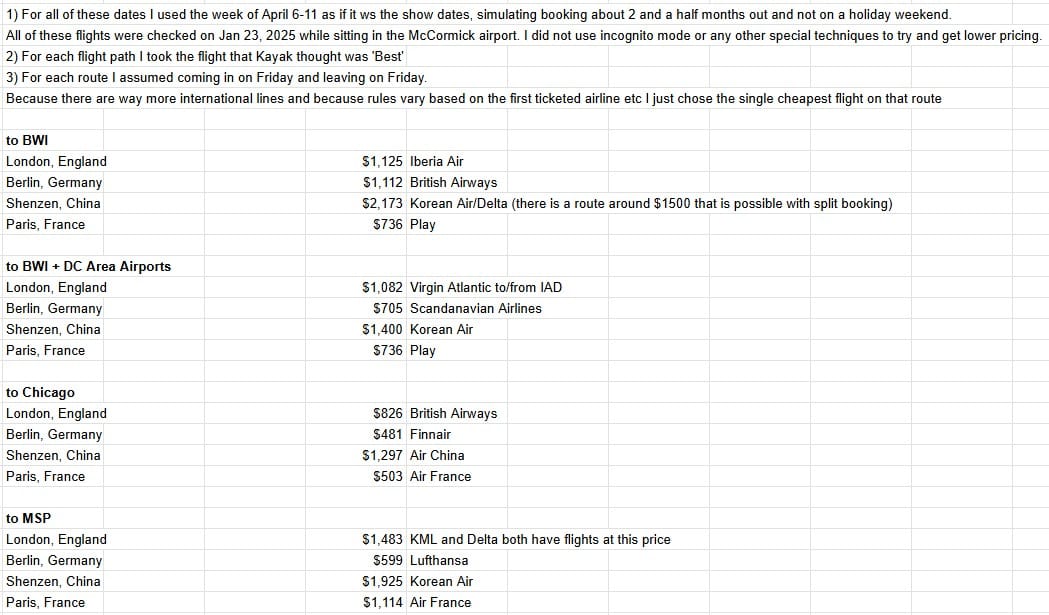
Domestic and International flight costs from Andrew's research (shared with the permission of Andrew Zorowitz).
I have not honestly spent a great deal of time looking at plane tickets, because I'm one of those people. I only fly United, and cost is the not the determination, number of stops is. This is why I also try to live on airline hubs, because taking a flight from point A to point B, but having to go through points C, D, E, and F, are my own private hell. Right after GAMA EXPO I went to International Festival de Jeux in Cannes, which meant I flew Chicago to Louisville, Louisville to Dulles, Dulles to Belgium, Belgium to Nice, and then took a cab to Cannes.
Coming home I went Cannes to Nice via Uber, Nice to Munich, Munich to Chicago.
The only positive thing I can say about a flight schedule like that is that I got a pissing boy magnet in Belgium for my girlfriend.
So Andrew would not commit to making a choice here, which I respect, but I also don't feel qualified to make a choice when it comes to these costs and how they affect things, so here is some info for my publishing friends, and I'm moving on to the last thing I wanted to discuss.
During site visits, someone posted on the GAMA Member Page about crime rates, and how can we talk about member safety when we're in Chicago and Baltimore, which are apparently crime-ridden ghettos populated by drug dealers or something, so I want to talk about this, with pictures!
When we head to Louisville we don't care about crime rates in all of Louisville, we care about the mile around the convention center, right? The same holds true for Baltimore, Minneapolis, and Chicago, because I'm not wandering into the most crime-ridden parts of town, far from the convention, I'm staying within that walking distance area of the convention center, unless I'm in a cab heading to and from the airport. So, let's actually talk crime, with pictures!
When I talk about safety I'm not even talking about crime rates. I'll admit to a great deal of privilege here, but I'm a six-foot tall white dude, I've wandered the streets of cities big and small, in the daylight, in the evening, and in the middle of the night, and I can't tell you I've ever felt unsafe; Montmartre at 3:00 AM, Koreatown Los Angeles at midnight, and away from Joe Louis Arena in a Colorado Avalanche sweater at the height of the rivalry. I feel pretty safe everywhere.
But when I talk about safety, I mean the stuff that doesn't personally affect me. I mean women's health care. I mean trans rights. I mean institutionalized bigotry. When I say 'I want our attendees to be safe and feel safe' I'm talking about human rights, but other people want to talk about crime rates, so let's do it.
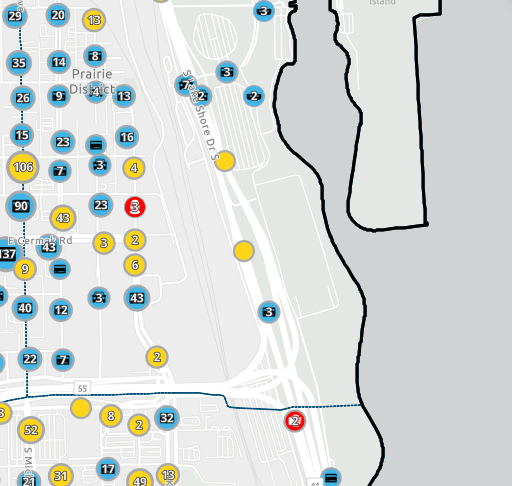
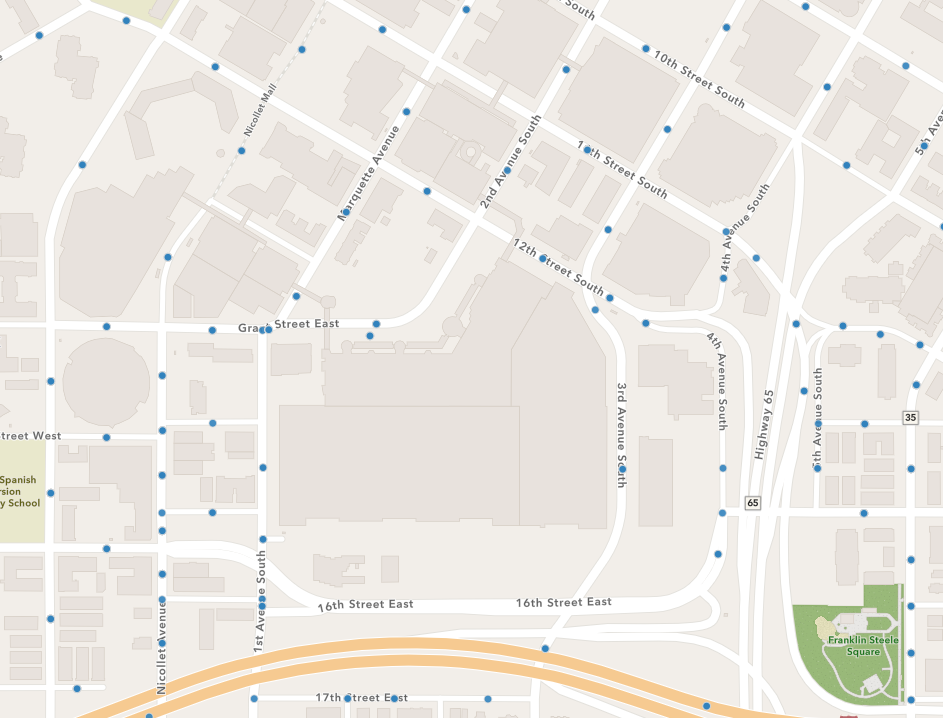
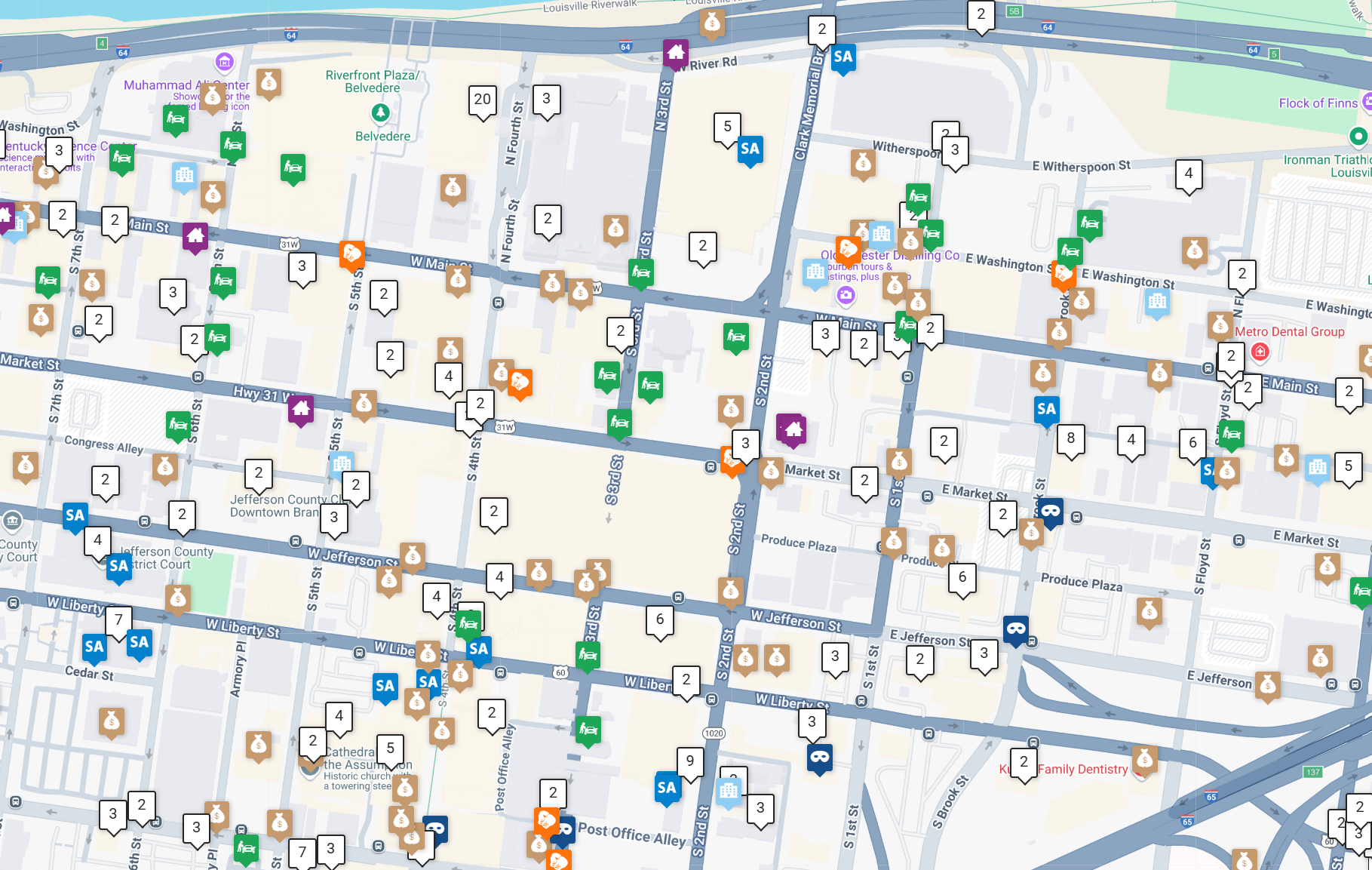
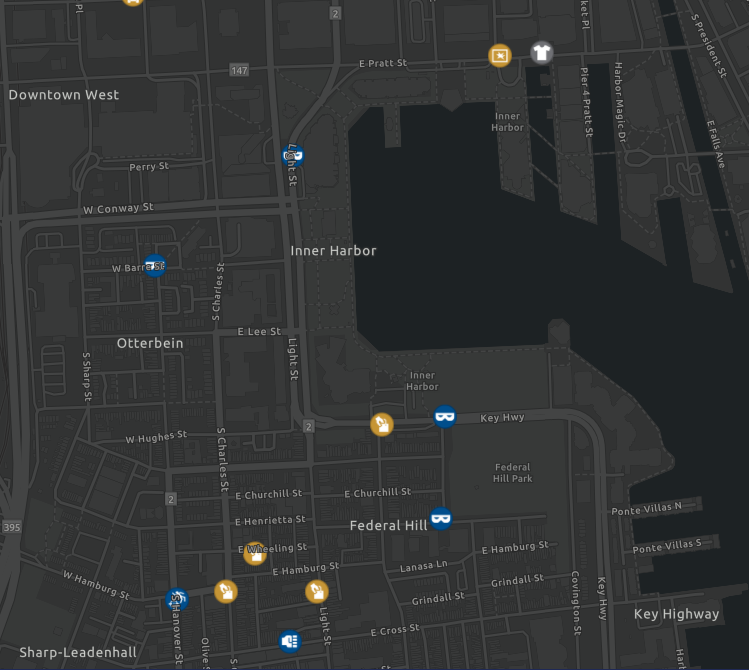
Chicago, Minneapolis, Louisville, and Baltimore Crime Statstic pictures.
I've attached a picture from each city, centered on the convention center in each (including Louisville), and you can see for yourself what types of crimes are occurring in those areas. I want to point out a couple of things. These are roughly one mile around the convention center, for the last 365 days before the screenshot was captured (which was before GAMA EXPO of 2025).
Let's start with Chicago, where you'll see several squares with BIG crime numbers (106, 90, and 137). These are mostly pickpockets, and those numbers are assigned to the public transit stadium where they discovered and reported, but that doesn't mean they occurred there. Despite that caveat, let's admit that the crime stats in the area around the convention center are not impressive.
The Minnesota picture shows lots of little blue dots, but they do a worse job of reporting the crime type, so it's hard to get that data easily, but you can see the blue dots around the convention center. It's also difficult to tell from the picture if these crimes are occurring on the streets or in the hamster tunnels, which criss-cross the area around the convention center and make it easy to get around with being exposed to the elements, but also provide a weird experience. The hamster tunnels are owned and maintained by a variety of business interests, who do an inconsistent job doing it, so one tunnel we walked through had a disgusting mess that stuck around the entire time we were there without being cleaned up (this was, to be fair, outside the hotel being renovated, so they may not have been doing anything with their hamster tunnel).
The Louisville picture is honestly the most disconcerting to me, because there are a lot of little pictures on there. The little money bag ones are mostly property crimes (break-ins), the little mask is mostly pickpockets (with a handful of aggravated assaults), and blue squares that say SA are sexual assaults. Louisville is the only one of the four cities I looked at with reported sexual assaults in the area we use.
But let's talk about that Baltimore picture.
There are 12 crimes on the map. Literally, that's it, 12 crimes. There are a couple of assaults, a couple of robberies, a single car-jacking, and a couple of break-ins, most of those at residential properties a few blocks south of the convention center.
Baltimore Convention Center works with a Welcoming Baltimore group that walks foot patrols, and provides escorts back to wherever you're going in the event you're not comfortable making the trip. It's the most exciting thing I heard from anyone in regards to the safety of convention attendees.
There is crime everywhere, even in the places I most love, but I thought Baltimore was doing the most to mitigate that risk, and it shows in the reported crime statistics of the area around the convention center.
So food goes to Baltimore, with Minneapolis in second place.
The safety of my friends (from a criminal statistic) also goes to Baltimore, with Minneapolis in second place (and arguably Louisville worse than any of the places we're considering).
So how do I rank things?
Getting there - Chicago, Baltimore, Minneapolis.
Hotels - Chicago, Baltimore, and I wouldn't stay in the room block in Minneapolis.
Convention Centers - Minneapolis, Baltimore, Chicago.
Food - Baltimore, Minneapolis, Chicago.
Crime Rates - Baltimore, Minneapolis, Chicago.
Vendor Costs - For people smarter than me, but it seems like Chicago finishes last.
GAMA costs - Baltimore, Minneapolis, Chicago (from what I know of the proposals that were sent).
Paint me orange, order some crabcakes, and call me Team Baltimore.
Next Friday we move onto the other things we'll be doing in this blog, like talking about profit margins, things to think about as a resident of the United States of Tariffs, and budgeting yourself for success on day one.
But now, we're apart to throw out the first pitch of the Rockies season, so I'm off to baseball!
(Don't forget, if you sign up for a free membership here you'll get emailed when new posts go live, and you'll be able to leave comments, something you can't do if you're reading without logging in.)